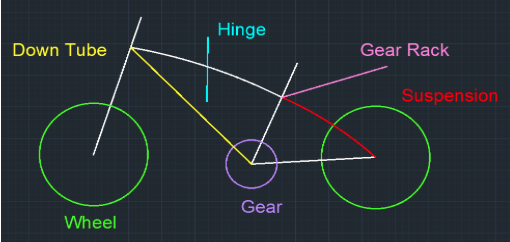Abstract
How do we develop an electronic mountain bike that is able to be transported easily and capable of jumping out of an aircraft?
We were given the Aventon Sinch Foldable EBike for research purposes. We studied its specifications and architecture. From there, we narrowed down our focus to three main areas: frame (design and material), battery, and wheel model.
Problem Statement
How should we use simple and reliable designs that extend the range of human operators without adding extra burden or complexity?
How can we make it suitable for long missions on mountainous terrain?
By focusing on frame design, frame material, battery, and wheel model, will our final product/idea be a novel and useful solution?
Proposal
As for frame design, we wish to incorporate a collapsible bike design that can be jumped with, all the while providing stability.
As for the jump-ability, we came to the conclusion of a collapsible bike via hinge over the other options: snap and telescoping.
As for the frame material, after much research, we learned that aramid would be the best material for the frame, due to its pros of having a balanced strength-to-weight ratio, high tensility, and low creep. In addition, it has a high high capability to absorb shock and impact, is extremely heat resistant, and is already frequently used in military aerospace operations.
In addition, we would use the concept of butted tubing, which is customizing tube thickness to remove excess material that is unnecessary for strength or performance. This would provide optimal strength-to-weight ratio, increased stiffness, and improved capability to absorb impact.
As for the battery, we wish to find the most efficient model needed for the development of this bike. Therefore, we found that using a 52-volt, 19.2 amps/hour lithium-ion battery park would utilize 14 18750-fire-resistant batteries and sustain over a 50-mile distance. This model would be 11 pounds, need two-three hours to recharge, and most importantly, is DoD approved.
This battery would be best placed internally within the frame or underneath the seat, considering its size of 1.4 inches by 18 inches.
Lastly, as for the wheel model, we plan on using reinforced spokes to match the high intensity usage, airless tires to best withstand rugged activity and be replaced less frequently than tires with air, and a regenerative braking system in order to have reliable charge times, conserve fuel, and reduce level of wear and tear on the breaks.
Challenges and Unknowns
We plan on doing further research on the Aventon Sinch Foldable EBike in order to gain a better understanding on some points we may be currently missing to better our idea for the final product.
In addition, we plan on comparing if we should add modifications to the current bike or building a new bike from scratch with our ideas.

 OUSD Research and Engineering
OUSD Research and Engineering  West Point
West Point
Comments
RyanBritt217 | 16 October 2021
I am from the other e-bike…
I am from the other e-bike group(Titanium Leopard) and was wondering if your team would want to either collaborate on a design or work together and share progress and ideas, but keep two competing designs.
Send me an email (ryan.britt@sju.edu) if interested, or join the group me that I have linked on my post.
cw579 | 22 October 2021
I’m also interested in…
I’m also interested in collaborating with your group, since I am the lone cadet who submitted a proposal from my detachment (Cornell University). My email is cw579@cornell.edu if you want to reach out.
Thanks,
Colby